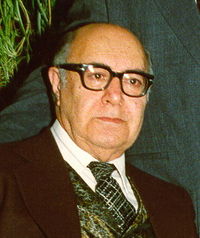Fereydoon Motamed Writer
Amir Fereydoon Motamed (AKA Amir Fereydoun Motamed or Fereydoon H. Motamed), 1917–1993, was an internationally known professor and linguist, winner of the Louis de Broglie award, from the Académie française, and recipient of literary award "Le Grand Prix Littéraire d'Iran" from Writer's Association of French Language.Fereydoon was son of an Iranian surgeon, Dr. Hossein Khan Motamed, chief of the surgery department in Razi Hospital, Tehran, Iran (1919–20) and founder of Motamed Hospital in Tehran. Fereydoun was inspired by paradigm of Structuralism as it pertains to linguistics. He devoted his life to research in aesthetics of linguistics, music, and poetry Versification in Indo-European languages using logic, and meter (poetry) metrics analysis. He was a professor of Language & Social Sciences and the director of the cultural activities committee at the Anglo Iranian Oil Company (AIOC) Institute of Technology, Abadan, Iran later renamed to Petroleum University of Technology. He is also the recipient of the Broglie award from the Académie française in 1963, and literary award "Le Grand Prix Littéraire d'Iran" from Writer's Association of French Language Association Des Ecrivains De Langues Françaises: A.D.E.L.F. in 1976.Mr. Motamed was a native of Iran and a resident of St. Mary's County, Maryland in the United States of America. He had his elementary and high school education in France near Paris. In 1946 he immigrated to the United States and earned his Master of Arts degree from Columbia University in New York City with his major in French literature. Later on, he devoted his life to research in the aesthetics of the temporal time in relation to the Indo-European languages and quantitative Meter (poetry), and he was the author of four books on that topic, the last of which is unpublished. His book De la metrique was honored to enrich the Nobel Library at Svenska Akademiens Nobelbibliotek, Börshuset, Stockholm, Sweden. He received many awards and praises from Académie française: Institute de France, Académie des Sciences, Paris, France, some of which are listed under the Awards and Honoraria.He was the cultural representative of the Holland's house of students of the Cité Internationale Universitaire de Paris and a member of the Central Assembly of the former students of the Cité Internationale Universitaire de Paris. He was the professor of Language & Social Sciences and the director of the cultural activities committee, Anglo Iranian Oil Company (AIOC) Institute of Technology, AKA Petroleum University of Technology, Abadan, Iran. He also was the English and French professor and chairman of the French department, Bu-Ali Sina University, Hamadan, Iran.His first book "De la Métrique: ou des accords des temps révolutifs dans les langues quantitativement flexionnelles", published in 1962, studies and analyzes aesthetics of linguistics and poetry in Indo-European languages using metrics analysis.His next book "Précis Logistique de l'harmonie métrique", published in 1963, is a complement on the scientific aspects of temporal proportions viewed as harmonic rings and sets."His third book" "La métrique diatemporelle: ou des accords de temps revolutifs dans les langues à flexions quantitatives", published in 1974, is a richer study and analysis of quantitative poetic meters, the measured characteristic movement of a verse, of the Indo-European languages. In 1984, a manuscript of his latest research led to the very origin of the well tempered quantitative poetic meters of the Indo-Persian languages. This manuscript was a complement to the 1974 publication, "La métrique diatemporelle". The structured approach which finally led him to the Greek linear musical scales and harmonics and consequently to the cybernetic models regulating the rings of aesthetic group, deals evidently with the intensive forms of diachronic harmony; however, he believed that in languages where the short syllables are more frequent than the long ones (referring to the duration without any other arbitrary engagement which may be added to it) extensive diachronic eurythmy is in fact not only practicable, but very valuable too. An exemplary copy of the manuscript was sent to the Director of the Library of the Irish Academy.Prior to his sudden death from heart attack he completed his 41 years of research on aesthetics of temporal time in relation to the Indo-European languages, and among his new findings he found a universal formula (what he used to call the "absolute zero" of linguistics) that is applicable to quantitative poetic meters of all the Indo-European languages. He claimed that this was root cause for why certain languages will become extinct (language death) in near future; however, he did not have the chance to finalize the editing of the fourth edition of his book in that subject, but his unpublished manuscripts are available for sharing upon request. All scholars that are interested in such a specialized field and are likely to build upon his work, are invited to contact motamedd@gmail.com to request copies of his unpublished manuscripts as a tribute to him and to the world of literature and linguistics.
Search
Writer
| genre | |
|---|---|
| influenced | L. P. Elwell-Sutton |
| influenced by | |
| movement |
Fereydoon Motamed on Wikipedia
External resources
- http://catalog.nypl.org/search/aMotamed%2C+Amir+Ferydoun./amotamed+amir+ferydoun/-2%2C-1%2C0%2CB/frameset&FF=amotamed+amir+ferydoun&1%2C1%2C
- http://catnyp.nypl.org/search/aMotamed%2C+Amir+Ferydoun./amotamed+amir+ferydoun/-2%2C-1%2C0%2CB/frameset&FF=amotamed+amir+ferydoun&1%2C1%2C
- http://translate.google.com/translate?hl=en&sl=sv&u=http://libris.kb.se/hitlist%3Fq%3Dzper:%2522%255EMotamed%2520Amir%2520Ferydoun%255E%2522%26p%3D1%26m%3D10%26d%3Dlibris%26f%3Dbrowse&sa=X&oi=translate&resnum=2&ct=result&prev=/search%3Fq%3DLa%2Bm%25C3%25A9trique%2Bdiatemporelle%26hl%3Den%26client%3Dfirefox-a%26rls%3Dorg.mozilla:en-US:official%26hs%3DQWk
- http://www.amazon.fr/dp/B0014RMWGS
- http://www.arsversificandi.net/resources/pdf/L4.PDF
- http://www.iranicaonline.org/articles/aruz-the-metrical-system
- http://www.put.ac.ir/WebUI/uniform/Default.aspx
- http://www.svenskaakademien.se/LitiumInformation/site/page.asp?page=1
